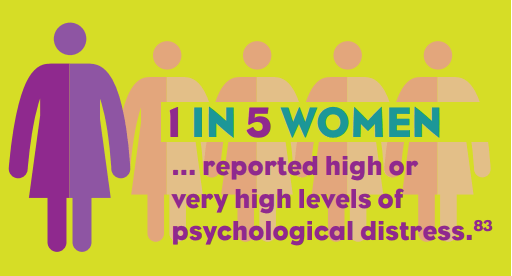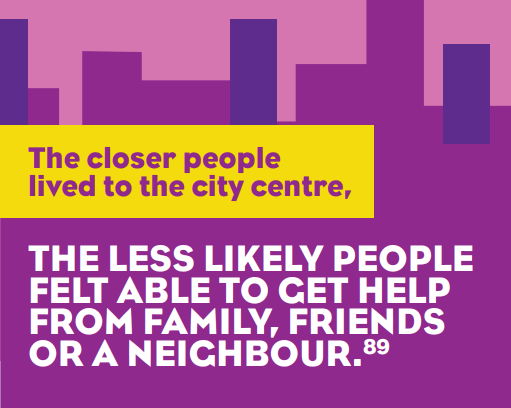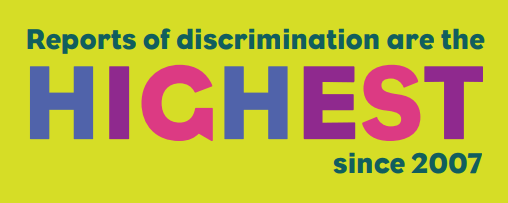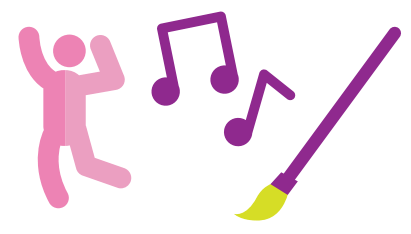The current situation
Fewer adults report good health
In their self-assessment of overall health, 41 per cent of adults living in Greater Melbourne reported excellent or very good health.1 This is a decline from five years ago when 47 per cent reported feeling excellent or very good about their health.2
Rural Victorians reported greater life satisfaction than people who lived in the city, and women reported greater life satisfaction than men.3
Across Victoria, approximately 17 per cent of people, and one in five women, reported experiencing high or very high levels of psychological distress.4
 5
5
In Greater Melbourne, and across Victoria, 24 per cent of adults said they had been diagnosed with depression or anxiety at some point in their lives. This increase is up from 19 per cent in 2011.6
Children are in good health
Most children in Greater Melbourne are reported to be in good physical and emotional health. 87 per cent of children up to 13 years of age have ‘good’, ‘very good’ or ‘excellent’ health, slightly below the Victorian average of 89 per cent.7
Burden of disease for Indigenous Australians
For every 1,000 Indigenous Australians, 429 years were lost to premature death, disease or injury compared to 185 years for non- Indigenous people. This represents a five per cent improvement for Indigenous Australians since 2003. Much of this change is a result of delaying deaths caused by particular diseases rather than preventing them. The consequence is that Indigenous populations are living longer with disease.8
Ageing can bring loneliness, isolation
At least one in ten people aged over 60 experience isolation and loneliness.9
Loneliness and social isolation significantly increases the risk of ill health and death. The chances of premature death increase for those experiencing loneliness by 26 per cent and for those experiencing social isolation by 29 per cent.10
Seniors are increasingly taking up new technology which can support them to build and sustain connections to their community. With more services and businesses online, seniors also need to be able to access support services via the internet.11
Building trust and social cohesion
A community’s capacity to manage adversity and provide support is based on people’s trust in others and sense of interconnectedness. In Greater Melbourne, 38 per cent of people believed others could be trusted, similar to Victoria overall.12
51 per cent of people were confident they would be able to seek help from family, friends or a neighbour if they were in need. By contrast, 64 per cent of people in rural Victoria felt confident they could get help if needed.13
-(1).png.aspx)
 14
14
Discrimination is increasing
Across Australia, discrimination based on skin colour, ethnic origin or religion has increased. 20 per cent of people reported experiencing discrimination, up from 15 per cent in 2015. Reports of discrimination are the highest since 2007.15

Religious bias is likely to be a significant contributor, with one quarter of survey respondents describing a ‘negative’ or ‘very negative’ attitude towards Muslims, a value that has remained consistent since 2010.16
Accessible community spaces are essential
Access to parks, schools, shops and public transport plays a critical role in the liveability of a city. Using public open spaces and being outside promotes physical activity and mental health and is known to reduce stress and illness.17
People living in car-dependent neighbourhoods who do not have a car are at increased risk of social isolation, reduced employment and skill development opportunities. As a result they become trapped in a cycle of debt.18
People living in disadvantaged areas are also less likely to have access to green spaces and other amenities, such as sporting grounds, compared with less disadvantaged neighbourhoods.19
Preparing for extreme weather
Heatwaves pose a significant threat to people’s health and wellbeing in Australia, causing cardiac arrest, heat stroke and dehydration.20
 21
21
Climate change increases the frequency and intensity of prolonged heatwaves, placing greater demand on public health and emergency services. As a result, communities need to prepare for extreme weather events.22
People most at risk of heat-related illness or death include:
- infants
- the elderly
- those with existing health problems or disabilities
- those who are isolated, homeless or work outdoors.
Some people also overestimate their personal tolerance to extreme heat.23
More than 88 per cent of the existing global burden of disease attributable to climate change occurs in children younger than five years.24
The number of people with heat-related health issues across Victoria during the 2014 heatwave was five times greater than expected. That year, 167 additional people died as a result of extreme heat.25
The heatwave of 2009 had an even more severe effect on the health of Victoria’s population. Emergency departments reported that heat-related health issues were eight times greater than normal.26 Bushfires that coincided with the end of the heatwave claimed the lives of 173 people. As a result 374 deaths above the anticipated mortality rate were attributed to the heatwave.27
Many Melburnians are not getting enough exercise
‘Sufficient’ physical activity is described as 150 minutes of moderate exercise or 75 minutes of vigorous exercise per week for people aged 18-64. Thirty minutes of moderate exercise each day is recommended for people aged 65 and over.28
 29
29
Melburnians are also more sedentary than rural Victorians, with four per cent of city residents doing no physical activity, compared to 2.6 per cent in the country.30
The largest differences in physical activity were seen between age groups, rather than location. People aged 45-64 years across Victoria were the least likely to exercise, with fewer than 37 per cent engaging in 150 minutes per week. More than 70 per cent of 65-84 year olds engaged the recommended amount of exercise.31
On average, 27 per cent of city residents participated in sport compared to 40 per cent of regional Victorians.32
Women participated in sport at half the rate of men. Women reported feeling embarrassed or intimated by sports clubs as barriers to participation.33 59 per cent of women aged 18-24 said they found sports clubs daunting, compared with 35 per cent of men.34
Most participate in the arts

Community participation in the creative arts is high across Victoria with 48 per cent of people creatively contributing, similar to the national average. Visual arts and crafts were the predominately explored medium with 31 per cent of people engaged in visual arts compared with only nine per cent involved in theatre and dance.35
Attendance rates were much higher than active participation. 72 per cent of people attended at least one art form. An additional 22 per cent of people engaged with the arts solely through literature.36
Participation rates depended on location. In outer metropolitan areas of Melbourne, 66 per cent of residents had attended a performance or exhibitions in the past 12 months, compared with 74 per cent in regional Victoria and 75 per cent in inner metropolitan areas.37
References
1 Department of Health and Human Services, “Victorian Population Health Survey 2015,” July 2017. [Online]. Available: https://www2. health.vic.gov.au/Api/downloadmedia/%7B5CFA50CD-A7D4-4BF9-A 8B2-339B7C70289F%7D
2 Department of Health, “Victorian Population Health Survey 2011- 12,” 2014. [Online]. Available: https://www2.health.vic.gov.au/ public-health/population-health-systems/health-status-of-victorians/survey-data-and-reports/victorian-population-health-survey/ victorian-population-health-survey-2011-12
3 Department of Health and Human Services, “Victorian Population Health Survey 2015,” July 2017. [Online]. Available: https://www2. health.vic.gov.au/Api/downloadmedia/%7B5CFA50CD-A7D4-4BF9-A 8B2-339B7C70289F%7D
4 Department of Health and Human Services, “Victorian Population Health Survey 2015,” July 2017. [Online]. Available: https://www2. health.vic.gov.au/Api/downloadmedia/%7B5CFA50CD-A7D4-4BF9-A 8B2-339B7C70289F%7D
5 Department of Health and Human Services, “Victorian Population Health Survey 2015,” July 2017. [Online]. Available: https://www2. health.vic.gov.au/Api/downloadmedia/%7B5CFA50CD-A7D4-4BF9-A 8B2-339B7C70289F%7D
6 Department of Health and Human Services, “Victorian Population Health Survey 2015,” July 2017. [Online]. Available: https://www2. health.vic.gov.au/Api/downloadmedia/%7B5CFA50CD-A7D4-4BF9-A 8B2-339B7C70289F%7D
Department of Health, “Victorian Population Health Survey 2011- 12,” 2014. [Online]. Available: https://www2.health.vic.gov.au/ public-health/population-health-systems/health-status-of-victorians/survey-data-and-reports/victorian-population-health-survey/ victorian-population-health-survey-2011-12
7 Department of Education & Training, “Young People with Good Health,” July 2015. [Online]. Available: http://www.education.vic.gov. au/Documents/about/research/VCAMS_Indicator_7_8b.xlsx
8 Australian Institute of Health and Welfare, “Australian Burden of Disease Study: Impact and Causes of Illness and Death in Aboriginal and Torres Strait Islander People 2011,” 23 September 2016. [Online]. Available: https://www.aihw.gov.au/getmedia/ e31976fc-adcc-4612-bd08-e54fd2f3303c/19667-bod7-atsi-2011. pdf.aspx?inline=true
9 Commissioner for Senior Victorians, “Ageing is Everyone’s Business,” Department of Health and Human Services, Melbourne, 2016.
10 J. Holt-Lunstad, T. Smith, M. Baker, T. Harris and D. Stephenson, “Loneliness and Social Isolation as Risk Factors for Mortality: a Meta-Analytic Review,” Perspectives on Psychological Science, vol. 10, no. 2, pp. 227-237, 2015.
11 Commissioner for Senior Victorians, “Ageing is Everyone’s Business,” Department of Health and Human Services, Melbourne, 2016.
12 Department of Health and Human Services, “LGA Profile 2014 beta,” 2014. [Online]. Available: https://www.data.vic.gov.au/data/ dataset/lga-geographical-profiles-2014-beta
13 Department of Health and Human Services, “LGA Profile 2014 beta,” 2014. [Online]. Available: https://www.data.vic.gov.au/data/ dataset/lga-geographical-profiles-2014-beta
14 Department of Health and Human Services, “LGA Profile 2014 beta,” 2014. [Online]. Available: https://www.data.vic.gov.au/data/ dataset/lga-geographical-profiles-2014-beta
15 A. Markus, “Mapping Social Cohesion: The Scanlon Foundation Surveys 2016,” Monash University, Caufield, 2016.
16 A. Markus, “Mapping Social Cohesion: The Scanlon Foundation Surveys 2016,” Monash University, Caufield, 2016.
17 H. Badland, R. Roberts, I. Butterwoth and B. Giles-Corti, “How Liveable is Melbourne? Conceptualising and Testing Urban Liveability Indicators: Progress to Date,” The University of Melbourne, Melbourne, 2015.
18 H. Badland, R. Roberts, I. Butterwoth and B. Giles-Corti, “How Liveable is Melbourne? Conceptualising and Testing Urban Liveability Indicators: Progress to Date,” The University of Melbourne, Melbourne, 2015.
19 H. Badland, R. Roberts, I. Butterwoth and B. Giles-Corti, “How Liveable is Melbourne? Conceptualising and Testing Urban Liveability Indicators: Progress to Date,” The University of Melbourne, Melbourne, 2015.
20 L. Hughes, E. Hanna and J. Fenwick, “The Silent Killer: Climate Change and the Health Impacts of Extreme Heat,” 2016. [Online]. Available: https://www.climatecouncil.org.au/uploads/b6cd- 8665c633434e8d02910eee3ca87c.pdf
21 L. Hughes, E. Hanna and J. Fenwick, “The Silent Killer: Climate Change and the Health Impacts of Extreme Heat,” 2016. [Online]. Available: https://www.climatecouncil.org.au/uploads/b6cd- 8665c633434e8d02910eee3ca87c.pdf
22 L. Hughes, E. Hanna and J. Fenwick, “The Silent Killer: Climate Change and the Health Impacts of Extreme Heat,” 2016. [Online]. Available: https://www.climatecouncil.org.au/uploads/b6cd- 8665c633434e8d02910eee3ca87c.pdf
23 L. Hughes, E. Hanna and J. Fenwick, “The Silent Killer: Climate Change and the Health Impacts of Extreme Heat,” 2016. [Online]. Available: https://www.climatecouncil.org.au/uploads/b6cd- 8665c633434e8d02910eee3ca87c.pdf
24 L. Hughes, E. Hanna and J. Fenwick, “The Silent Killer: Climate Change and the Health Impacts of Extreme Heat,” 2016. [Online]. Available: https://www.climatecouncil.org.au/uploads/b6cd- 8665c633434e8d02910eee3ca87c.pdf
25 Department of Health and Human Services, “Research and Reports - Extreme Heat and Heatwaves,” [Online]. Available: https://www2. health.vic.gov.au/public-health/environmental-health/climateweather-and-public-health/heatwaves-and-extreme-heat/heatwave-research
26 Department of Human Services, “January 2009 Heatwave in Victoria: an Assessment of Health Impacts,” 2009. [Online]. Available: https://www2.health.vic.gov.au/Api/downloadmedia/%7B959CCD3C -8285-4938-872E-62E15AA62C62%7D
27 Australian Bureau of Statistics, “The Exceptional Heatwave of January-February 2009 in South-Eastern Australia,” 4 June 2010. [Online]. Available: http://www.abs.gov.au/AUSSTATS/abs@.nsf/ Lookup/1301.0Chapter1042009%E2%80%9310
28 Department of Health and Human Services, “Victorian Population Health Survey 2015,” July 2017. [Online]. Available: https://www2. health.vic.gov.au/Api/downloadmedia/%7B5CFA50CD-A7D4-4BF9-A 8B2-339B7C70289F%7D
29 Department of Health and Human Services, “Victorian Population Health Survey 2015,” July 2017. [Online]. Available: https://www2. health.vic.gov.au/Api/downloadmedia/%7B5CFA50CD-A7D4-4BF9-A 8B2-339B7C70289F%7D
30 Department of Health and Human Services, “Victorian Population Health Survey 2015,” July 2017. [Online]. Available: https://www2. health.vic.gov.au/Api/downloadmedia/%7B5CFA50CD-A7D4-4BF9-A 8B2-339B7C70289F%7D
31 Department of Health and Human Services, “Victorian Population Health Survey 2015,” July 2017. [Online]. Available: https://www2. health.vic.gov.au/Api/downloadmedia/%7B5CFA50CD-A7D4-4BF9-A 8B2-339B7C70289F%7D
32 VicHealth, “Sport Participation in Victoria 2015,” 29 November 2016. [Online]. Available: https://www.vichealth.vic.gov.au/-/media/ResourceCentre/PublicationsandResources/Physical-activity/2016-Sport-Participation-Research-Summary.pdf?la=en&hash=- C3469491EE07199D289541B8F22966288DD978C5
33 VicHealth, “Sport Participation in Victoria 2015,” 29 November 2016. [Online]. Available: https://www.vichealth.vic.gov.au/-/media/ResourceCentre/PublicationsandResources/Physical-activity/2016-Sport-Participation-Research-Summary.pdf?la=en&hash=- C3469491EE07199D289541B8F22966288DD978C5
34 VicHealth, “Young Adults (18-24) Physical Activity Insights,” 03 February 2017. [Online]. Available: https://www.vichealth.vic.gov.au/-/ media/ResourceCentre/PublicationsandResources/Life-Stages/LifeStages---Young-adults.pdf?la=en&hash=261BDB5CFE930BA75CBD6318D5CE7723F78144FC
35 Creative Victoria, “Arts in Daily Life,” December 2014. [Online]. Available: http://creative.vic.gov.au/research/reports/arts-in-daily-life
36 Creative Victoria, “Arts in Daily Life,” December 2014. [Online]. Available: http://creative.vic.gov.au/research/reports/arts-in-daily-life
37 Creative Victoria, “Arts in Daily Life,” December 2014. [Online]. Available: http://creative.vic.gov.au/research/reports/arts-in-daily-life